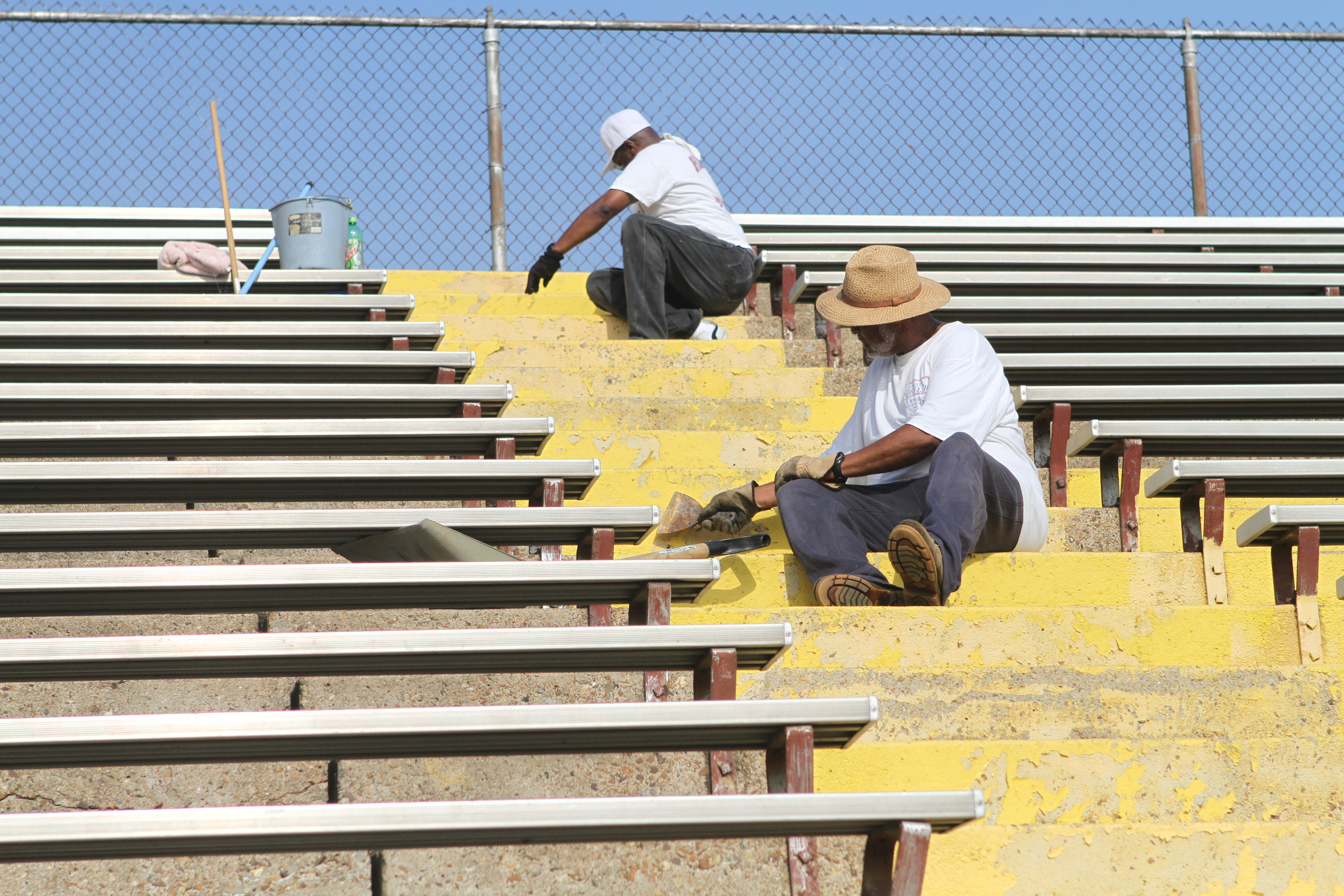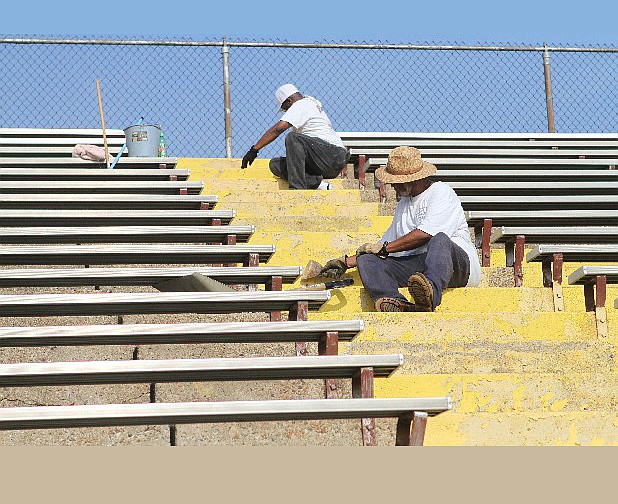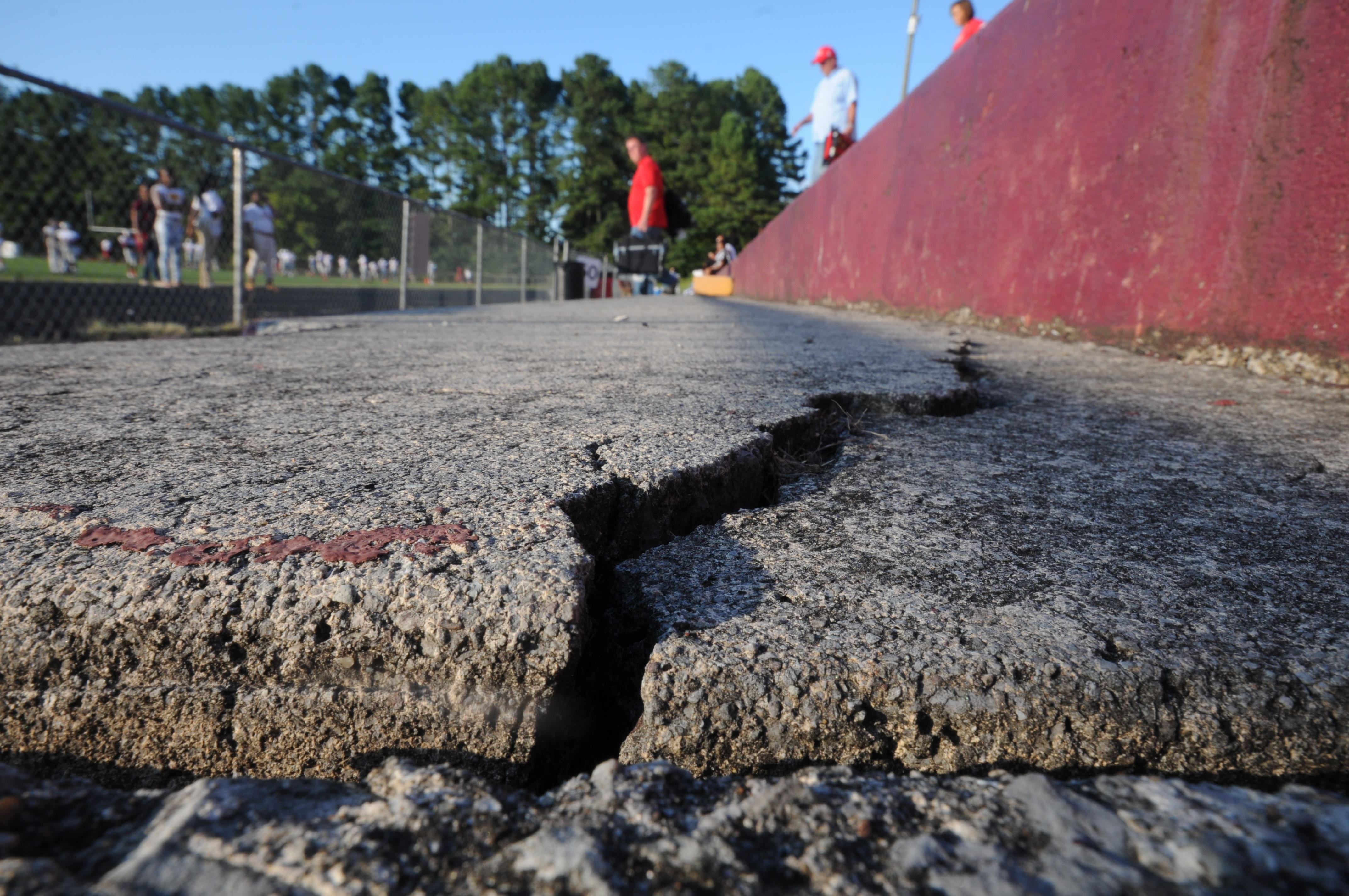 Henry Slayton, vice president of the Howard Alumni Association and a 1966 graduate of the school, and Donald McDaniel, a 1972 graduate, scrape paint off stadium steps as part of an alumni-driven overhaul on Saturday. "There used to be a lot of pride in this school and especially in the football program," Slayton said. "It was an honor to be on the Howard football team even if you were sitting on the bench." Alumni are working to rehab the stadium in hopes of restoring that school pride.
Henry Slayton, vice president of the Howard Alumni Association and a 1966 graduate of the school, and Donald McDaniel, a 1972 graduate, scrape paint off stadium steps as part of an alumni-driven overhaul on Saturday. "There used to be a lot of pride in this school and especially in the football program," Slayton said. "It was an honor to be on the Howard football team even if you were sitting on the bench." Alumni are working to rehab the stadium in hopes of restoring that school pride.Athletic boosters maintain that there are as many lessons to be learned on the field as in the classroom. Yet the long-standing practice in Hamilton County Schools has left individuals and communities largely on their own when it comes to footing the bill for sports.
Take the cases of Soddy-Daisy High and East Hamilton Middle-High, some 25 years apart. For the past few years, parents have been raising money for a baseball field at East Hamilton Middle-High, where team members now must travel across the county for practice and games. Parents say the field and other athletic facilities should have been built along with the school, which opened in 2009.
"I just think schools should be built completely, and that includes athletic facilities. They're utilized every single day by kids. It's part of the school. It's part of the community," said East Hamilton parent Ashlie Henderson, who has worked for years to raise money for facilities and supplies.
"That should have been done from the beginning. To piecemeal it after the fact is almost impossible for anyone outside the government."
So far, East Hamilton has been waiting for four years. But schools have waited much longer.
It took nearly 30 years for Soddy-Daisy High School to get its softball field. The school opened in 1983; the field finally opened in 2010. The team had been practicing and playing at an off-school site and it was only after concerns were raised over possible gender inequality in -- and possible lawsuits over -- Soddy-Daisy's athletic facilities that the field was built.
Aside from county-provided supplemental pay for coaches, school communities get little in the way of financial support for athletics. The nine county commissioners will often designate portions of their $100,000 annual discretionary funds toward athletic facilities or equipment.
Other money for athletics comes mostly from community support, athlete fees or private fundraising. Concession stands, game ticket sales and coupon books help buy balls, helmets and other supplies. Football and baseball coaches mow their own fields, plant grass and paint lines before game day.
That patchwork of funding has left some schools with soggy fields or crumbling stadiums. The problems are often worse in poorer schools, yet even schools in the wealthiest areas struggle.
Collectively, the Hamilton County Schools system says it has about $400 million in deferred maintenance and school construction needs. With such mounting requirements for schools' academic spaces, athletic programs tend to get short shrift.
Yet while classroom needs have generally been put ahead of athletic ones, education officials say it's time to invest in fields, stadiums and gymnasiums.
"Our athletic facilities are aged," said school board Chairman Mike Evatt. "They need to be addressed before we have a major accident of some sort."
To address the growing problem, Evatt said he'll soon introduce a package of funding for sports upgrades worth several million dollars. He anticipates getting several million from the sale of the old Ooltewah Elementary building, which could go toward repairs or new athletic facilities.
Aside from liability concerns, Evatt said sports provide an important piece of the overall educational experience.
"I think athletics are very important to a student's growth," he said. "It teaches you discipline. It teaches you teamwork."
And as new schools are built, Superintendent Rick Smith said they should be built with the necessary fields, tracks and stadiums, rather than adding them piecemeal after construction. Such was the case at Red Bank Middle, which opened this fall on the campus of Red Bank High. It's the first middle or high school in years to be built with a complete set of athletic facilities.
"As we look to the future, I think we have to include outdoor facilities," Smith said. "We're past the point of relying on the community."
There are two basic problems with county athletic facilities: Schools have outdated, deteriorating facilities or they lack facilities altogether. The latter issue stems from a building strategy that for several decades has resulted funded schools, but left fields and stadiums to be built later or by community members.
"Going back historically for 30 years, there's been very little money spent on athletics unless it was a commissioner's discretionary money," said Gary Waters, who oversees the school system's facilities.
The heavy reliance on coaches, commissioners and community generosity has left vast inequalities among schools' athletic stadiums, gyms and practice facilities. While Soddy-Daisy waited nearly three decades to get a softball field, Signal Mountain Middle-High got a significant jump start, with many athletic facilities coming online with the school's 2008 opening. But even Signal Mountain had to add on after the fact, and the school is still awaiting some facilities. Now, the visiting football team uses a tent as a locker room.
Some of the county's most outdated athletic facilities are at the city's poorest schools, where donations are harder to come by.
The track at the Howard School is in such disrepair that the championship-winning track team can't practice on its home surface, yet alone compete. Tyner Academy's football field is notorious for its huge crest at midfield, and fans must walk over a grassy hill to get to the home stands. At Brainerd High, nearly all the athletic facilities -- the football field, track, press box, restrooms and the home and away bleachers -- are considered in need of replacement.
"There are some schools you go to and you can't believe it's a high school. The kids will walk onto a field and say, 'How can we play on this?'" said Central High baseball coach Glen Carter.
Of course there are exceptions. Howard's Henry W. Bowles Gymnasium is considered one of the nicest high school gyms in the county.
Carter said the county's maintenance crews are sometimes able to help make more complex repairs such as plumbing fixes. But the routine stuff is left in his hands. He takes money from concession sales, player fees and ticket sales to buy grass seed and fertilizer each year. He takes care of reseeding the baseball field, mowing and dragging the infield dirt.
"It's pretty much just me and any volunteers I can get," he said.
The Howard School is one step closer to getting its long-awaited replacement stadium. The city of Chattanooga will soon transfer ownership of the nearby former Poss Homes public housing complex to the school system. School officials have long eyed that site for a new football and track stadium to replace the crumbling, outdated facility being used now. Such a project is estimated to cost about $4 million. But with so many other athletic and academic needs across the school system, it's unclear what Howard's chances are of getting a new stadium.
Waters estimates the county has about $40 million in unmet athletic needs that run the gamut from crumbling tracks to crummy bleachers. Some schools are missing entire practice or game fields, like Sale Creek Middle-High, which just launched its football program but has no home field.
"It's just a typical lack of available funding to do what needs to be done," Waters said. "There's just a huge backlog of needed improvements."
Contact staff writer Kevin Hardy at khardy@timesfreepress.com or 423-757-6249.

